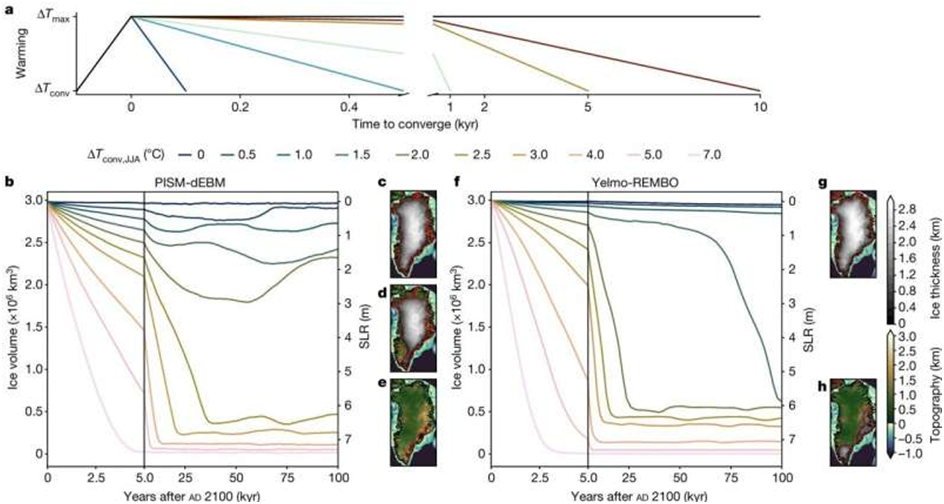How the Greenland ice sheet can nevertheless be stored
How the Greenland ice sheet can nevertheless be stored
Greenland is the world's second largest landmass covered by ice; only Antarctica is bigger. The Greenland ice sheet is greatly affected by the effects of climate change. If the ice melts completely it could cause a sea level rise of more than seven meters - a disaster for coastal areas around the world and for those who live there.
Time series of ice volume and spatial extents of the GrIS for warming scenarios without mitigation. a, Sketch of applied warming and cooling scenarios in this study. The warming period lasts for 100 years, followed by varying cooling phases. The black line corresponds to scenarios without mitigation as shown in this figure. b, Evolution of total GrIS ice volume simulated by PISM-dEBM, without reversal of the temperature anomalies (black line in panel a), for different temperature anomalies between ΔTJJA = 0 °C and 7.0 °C above present. The warming period lasts for 100 years until year ad 2100 and temperatures are kept constant afterwards. Three qualitatively different regimes are noticeable: (1) present-day configuration with fully extended ice sheet or only slightly reduced volume; (2) intermediate state with around 75% of present-day ice volume; and (3) basically ice-free states. The vertical black line at 5 kyr denotes a change of the x-axis scaling for visual clarity. We normalise the ice volumes to the observed present-day values (see Methods sections ‘PISM-dEBM’ and ‘Yelmo-REMBO’). c, Ice thickness of present-day ice-sheet configuration in PISM-dEBM. The ice sheet is fully extended. d, Same as c but the intermediate state for ΔTconv,JJA = 2.0 °C, after 100,000 years with PISM-dEBM. The southwestern part of the ice sheet is fully retracted. e, Same as c but for the ice-free state with PISM-dEBM. f,g,h, Same as b,c,e, respectively, but for Yelmo-REMBO. Only two regimes can be identified: (1) present-day configuration; and (2) near-ice-free states.
The critical level for the worst-case scenario is between 1.7 and 2.3 degrees Celsius of global warming above pre industrial levels on an annual average. Until now, climate research has assumed that if this point is exceeded, the Greenland ice sheet may be permanently lost. However, an international research team has now been able to show with a large set of simulations that there can be a trend again after passing the point.
Niklas Boers is Professor of Earth System Modeling at TUM and member of the Potsdam Institute for Climate Impact Research (PIK). Together with scientists from UiT The Arctic University of Tromsø and the Complutense University of Madrid, he has succeeded in proving that the tipping point for the Greenland ice sheet can briefly be exceeded without irreversible harm. Our simulations have proven to us that it's feasible to prevent the melting of Greenland's ice sheet in spite of failure to meet weather dreams and to even do the opposite. Here the crucial aspect is that if the tipping factor is passed, large countermeasures might be vital and the Earth would have to be cooled down to underneath the crucial values,says Prof. Niklas Boers.
Recovery possible, but only with concerted action
----------------------------------------------------------------------------------------------------------------------------------------------------




Comments